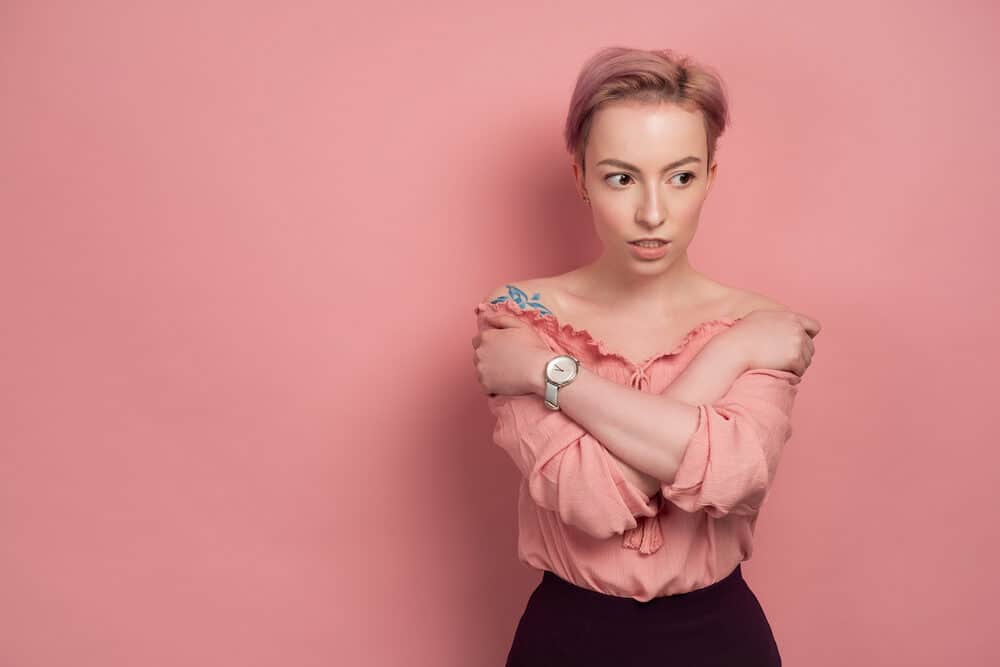
Waves are a popular hairstyle originating in the African American community. The style is highly sought after for its unique aesthetic, and people of all races and backgrounds want to try it.
Yet, given the distinct hair texture differences between black people and white people, many white people fear they can’t get waves.
If this sounds like you, read on! In this article, we will not only tell you whether white people can get waves but also provide in-depth instructions on how to achieve them.
Table of Contents
Can White People Get Waves?
White people can get waves! The truth is that Caucasian hair comes in various textures, from bone straight to tight ringlets. In most cases, all you need to get waves is a natural wave or curl pattern and some determination.
However, if you have thick straight hair, waves might be difficult–or even impossible–to achieve without using heat styling tools or chemical processing.

4 Things White People Should Consider Before Getting Waves
There are a few things you should know before you decide to get waves. Some of the information included in this section might be encouraging, and some of it may dissuade you from attempting waves.
Before getting waves, you should consider:
Your Hair Type
As mentioned before, this hairstyle is best suited for someone with naturally wavy hair or curly hair. If you have straight hair, especially thick straight hair, waves might not be the right hairstyle for you.
If you’re still set on achieving the style with having the right hair texture, you will likely have to use hot tools or get a curly perm first (both of which can damage your hair).
How Long You’re Willing to Wait
The straighter your hair is, the longer it will take to develop your waves. It can take up to 6 or 7 weeks before you start to see progress, even for people with curly hair.
If you’re looking for a quick hairstyle that you can get overnight, waves might not be right for you.

How Much Time You’re Willing To Spend
Waves are not only a hairstyle: they’re a full-on lifestyle. There’s a reason you see men with waves brushing their hair at seemingly every opportunity.
Waves can take months to develop, and the straighter your hair is, the more time it will take. Even after your waves form, they will still require daily maintenance.
If you want waves, you’ll have to make significant changes to your hair care routine.
This means brushing your hair multiple times a day, every day with a wave brush. The more consistent you are, the better your results will be. If this sounds like too much work, you should reconsider choosing this hairstyle.
How Often Do You Want To Change Your Hairstyle?
If you like to switch up your hair and play around with different styles, waves might be more of a commitment than you’re looking for.
It takes time and repetition to train your hair to lay in a specific wave pattern. If you undo your progress with frequent style changes, you’ll have to start all over.

Cultural Appropriation
It's common for black guys to wear waves, although a white person might be accused of cultural appropriation for wearing a wavy hairstyle.
You'll need to make the decision whether you're willing to deal with potentially receiving negative comments and looks about your hairstyle choice.
How To Get Waves
If you’ve decided that you’re ready to invest the time it takes to have waves, you’re probably wondering how to get them. In this section, we’ll tell you everything you need to know to get waves.
Materials you'll need
Follow the below steps to get waves:
- Shampoo and condition your hair.
- Rinse well.
- Rub a quarter-sized dollop of curl enhancer between your hands, and smooth it over your hair.
- Comb your locks to evenly distribute the product and work out tangles.
- Starting from the crown of your head, brush your hair forward 50 times. Focus on just the top of your head. You’ll do the sides later.
- Now, from the crown of your head, brush the back of your head down towards your neck 50 times. Use a handheld mirror to make sure you aren’t missing any sections.
- Finish the process by brushing the sides of your head forward towards your chin. Brush each side another 50 times.
- Once you’ve finished brushing your hair, it’s time to compress. Put on your durag or wave cap and secure it.
- Wear the cap for at least 30 minutes.
- Repeat the process two or more times each day.

How To Maintain Your Waves
Now that you know how to get waves, it’s time to learn how to keep them. Here’s everything you need to know to keep your waves defined.
Brush Your Hair Often
You’ll have to continue brushing your hair daily even after your waves have taken shape. Make sure you brush it in the same direction each time as you’re trying to coax your hair into following a specific pattern.
Even if you’re just combing the curl enhancing cream through your hair or running your hands over your head, always move in the direction of your waves. Whenever you comb or brush in the opposite direction, you're undoing your hard work.

Get Your Hair Cut Regularly
Haircuts are essential in maintaining your waves. Your hair should never be short enough for your scalp to peek through. 1 to 1½ inch hair is recommended, although you might need a more substantial cut, depending on your curl pattern.
When you get your haircut, make sure your barber knows that you’re trying to maintain waves. They’ll cut with the grain of your hair instead of against it. They might also be able to add layers to your hair, which can help give the illusion of deeper waves.
Cover Your Hair at Night
As you toss and turn in your sleep, your hair rubs against your pillow. The friction messes up your developing curl pattern and makes progress impossible.
Additionally, cotton pillowcases can suck the moisture from your locks and cause breakage. You can use a durag, wave cap, or silk scarf to keep your waves in place at night.

Do’s and Don’ts of Getting Waves
Now that you know the basics, we’d like to provide you with a list of dos and don’ts. Keeping these in mind will help ensure you’re able to achieve the waves you want.
Do’s
- Do airdry or use a diffuser to bring out your natural hair texture.
- Do use high-quality styling products to help you maintain your hairstyles.
- Do cover your hair at night to preserve your waves.
- Do wash your durag and brush often to avoid product buildup.
Don’ts
- Don’t brush your hair when it’s dry.
- Don’t overload your hair with product.
- Don’t use brushes with stiff plastic bristles.
- Don’t run your fingers through your hair.
- Don’t overwash your hair.

Best Styling Products for Getting Waves
When it comes to getting waves, your products can make all the difference. That’s why we’ve provided you with some of the best products around for getting waves. Here they are!
SheaMoisutre Smoothie Curl Enhancing Cream: This curl enhancing cream is considered a holy grail product for straight hair wavers. It gently coaxes out your natural curl pattern without weighing your locks.
Design Essentials Curl Enhancing Mousse: For frizz-free and flake-free curl definition, look no further than this curl-enhancing mousse. Its gentle formula is infused with strengthening wheat proteins and moisturizing almond oil.
Argan Magic Defining Curl Cream: The biotin and argan oil in this defining cream nourishes your locks for waves that are shiny and moisturized. This versatile cream detangles, conditions, and reduces frizz as it defines your curls.
- How To Make Edges on White Girl Hair
- Protective Hairstyles for Curly Hair White Girl
- Castor Oil for Hair Growth White Girl
- Can I Get a Weave if I’m White?
So, there you have it! We hope this article has shown you that white people can also get waves and given you the tools needed to achieve them.
Waves are a time-consuming hairstyle that might not work for everyone. But if you do choose to commit to the process, nothing beats the feeling of seeing your hard work pay off when the waves finally start to form.




